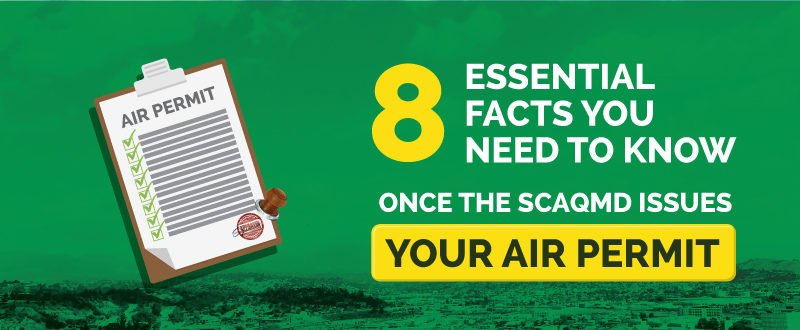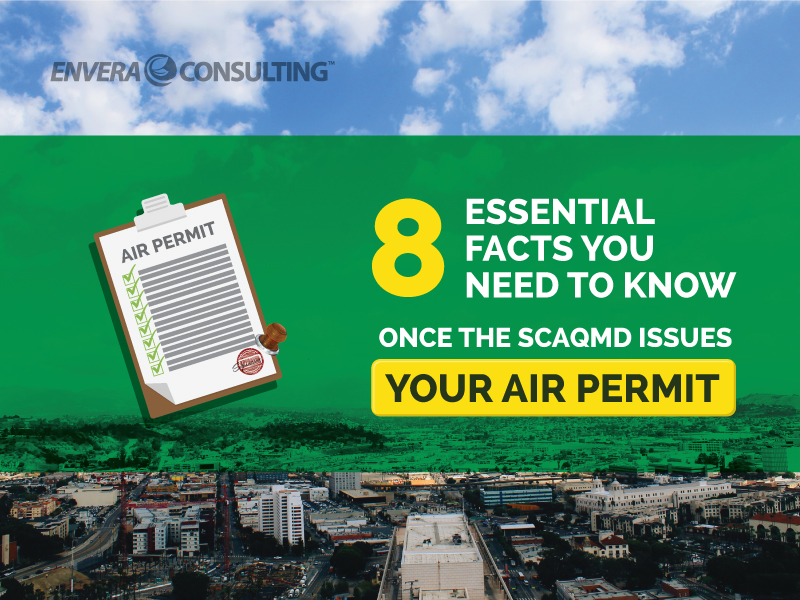

Congratulations! You managed to get your air permit from the South Coast Air Quality Management District (SCAQMD).
Unfortunately, preparing your air permit and going through the permitting process is only half of the story. As a holder of an SCAQMD permit, there are eight important points you need to understand.
1. A permit to construct expires after one year.
It’s important to remember that air permits expire. SCAQMD Rule 205 states that a permit to construct expires one year after it’s issued, unless an extension is granted.
There are, however, acceptable circumstances for extending a permit to construct. When requesting an extension, you need to demonstrate that you, the permit holder, are making continuous progress towards completion and that the delays have been outside of your control.
There are seven cases that an extension of a permit to construct can be granted:
- Your project is part of a multi-year project.
- Your project is facing a delay due to another agency.
- Your project is facing a delay in the utility hookups.
- Your project is facing a delay in the financing department.
- There is a delay in equipment delivery.
- There is a delay in the construction of the project due to a strike, natural disaster, design changes, or a contractor missing a critical deadline.
- Your project is facing a lawsuit, and you as the permit holder did not initiate the lawsuit.
If you think that you’re going to need more time to complete the construction of the project, it’s best to have a discussion with the SCAQMD before you need the extension.
2. A permit to operate must be renewed each year.
As with permits to construct, permits to operate also expire. Operating permits expire each year, and the only way to renew them is to pay an annual renewal fee.
If you don’t renew your air permit, the SCAQMD will cancel it, and you will no longer have the written authority to operate the piece of equipment. If this happens, and you want to operate the equipment, you will need to go through the entire process again to reinstate your air permit.
Depending on the situation, the process can be extremely complicated, especially if the Best Available Control Technology (BACT) for the equipment changed. So remember to pay your annual permit renewal fees!
3. In most cases, a permit must be posted next to the equipment.
SCAQMD Rule 206 states that the original air permit or a reasonable copy must be posted within eight meters of the equipment to ensure that the equipment descriptions and operation conditions are enforced.
If you have a facility permit, such as a Title V and/or RECLAIM permit, a copy of the facility permit must be kept in a central location, such as in the main office building, but it must be made available to the SCAQMD upon request.
4. Permits cannot be transferred to another owner.
When an air permit is issued, it’s issued to one specific owner and/or operator. SCAQMD Rule 209 prohibits the transfer of the air permit from one entity to another.
Sometimes, mergers and name changes do not constitute a transfer. In such cases, it’s best to seek legal advice for guidance regarding SCAQMD Rule 209.
5. Permits (usually) cannot be transferred from one location to another.
Similar to the transferring of air permits from one owner to another, SCAQMD Rule 209 specifically prohibits the transfer of one piece of permitted equipment from one location to another.
The SCAQMD does, however, issue a Various Locations Permit, which allows the movement of equipment between locations.
6. You must follow all conditions printed on the face of your air permit.
SCAQMD Rule 203 allows the SCAQMD to impose permit conditions on the face of your air permit. These permit conditions ensure that the equipment will be constructed and operated in compliance with all AQMD rules and regulations.
As a holder of an SCAQMD permit, you are obligated to operate the equipment in compliance with all of the rules and conditions of the air district, the Environmental Protection Agency and the California Air Resources Board, as well as the conditions listed on the face of the permit.
While it may seem tedious to follow the conditions on the face of the air permit, you can run into trouble when you have cases with:
- Permit conditions that conflict with a specific rule
- Permit conditions that are vague
- Permit conditions with incorrect formulas that specify how to calculate emissions
- Permit conditions that are inappropriate
It’s important to carefully review your air permit and immediately address any of these problems. SCAQMD Rule 204 allows the holder 30 days to review and amend the written conditions on any permit upon annual renewal to assure compliance with the rules and regulations. Most permit holders don’t know this and, as a result, miss their opportunity to review their permit conditions for accuracy.
When reviewing your permit, look at it through the lens of an inspector and ask yourself the following questions:
- How will the facility demonstrate compliance with this condition?
- What records are needed to demonstrate compliance with this condition?
- Does the permit description reflect the equipment in the field (model number, rating, physical descriptions, etc.)?
If you don’t get the permit conditions changed, some circumstances will require a variance petition from the SCAQMD Hearing Board to continue to operate your equipment in compliance. In other cases, you need to file a permit-modification application.
From our experience, many Title V facilities have permit problems when they first receive their permit, although the number of problems tends to decrease over time.
7. You cannot alter or falsify an air permit.
This may go without saying, but there’s a reason the SCAQMD created Rule 207, which prohibits the willful defacing, altering, forging or falsifying of any permit issued by the SCAQMD.
8. You may be required to prepare an annual emission report for your facility
In the SCAQMD, Annual Emission Reporting (AER) program is like taxes. The program requires certain permitted facilities to report their emissions from both permitted and non-permitted sources for the most recent year. These facilities must also pay a fee for any emitted pollutants that are above the given thresholds found in SCAQMD Rule 301.
It’s important to note that facilities are required to file an AER if they meet one or more of the following criteria:
- The facility’s emissions exceed the reporting thresholds in SCAQMD Rule 301.
- The facility is subject to the AB-2588 program for air toxics.
- The facility receives an SCAQMD notification to report, even if the facility’s emissions are below the reporting thresholds or no fees are due.
If you are required to file an AER, your report must be filed both via the SCAQMD electronic reporting tool and by submitting a hard copy.